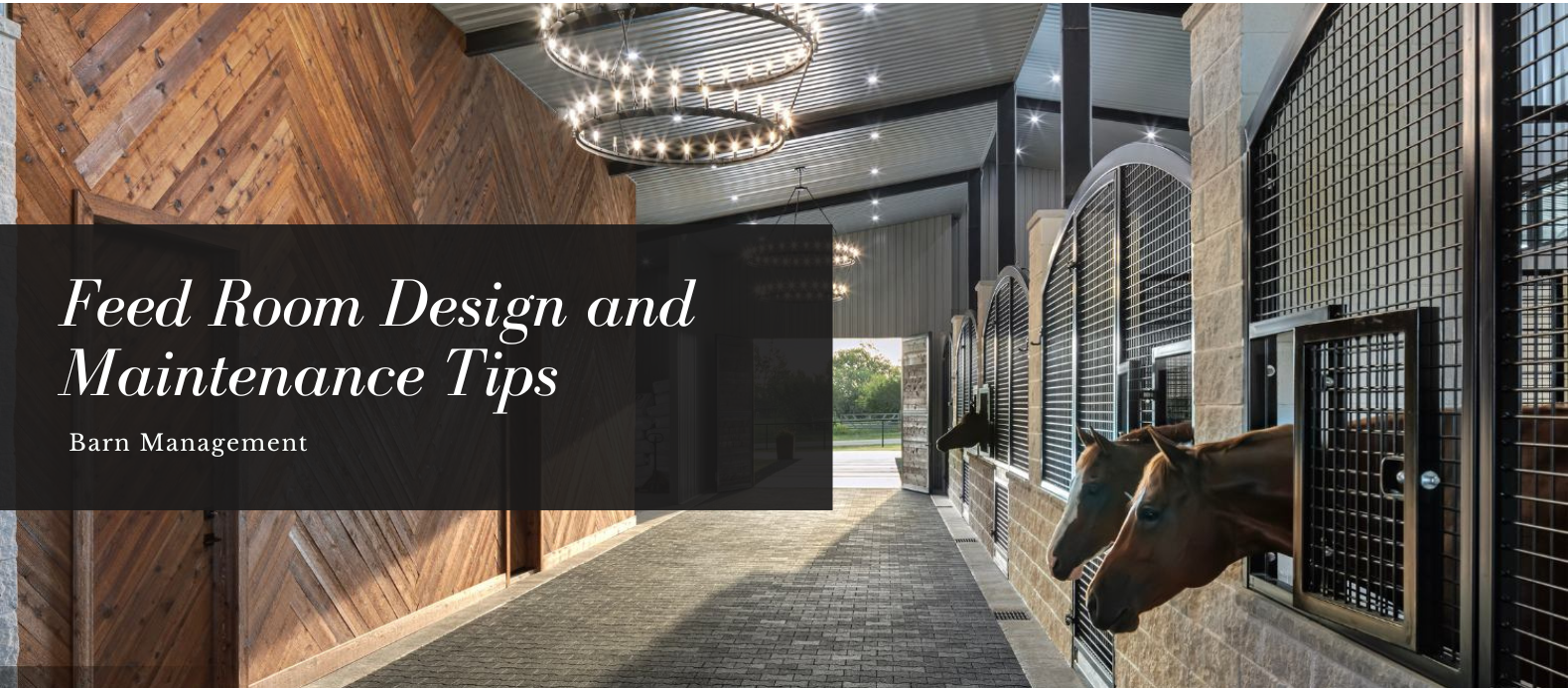Feed Rooms are often the heart of the horse barn. Horse feeding portions and schedules can often resemble high-level algebraic equations when it comes to getting each horse exactly what they need. While your horses feed and supplements might be complex, the feed room should make keeping each horses rations organized a simple process. When creating a feed room or revamping an existing space, there are some key features to keep in mind that will help make the barn run smoothly.
Secure Space – One of the most important features of a feed room should be security. Wherever feed is stored, it needs to be made inaccessible to horses. Just one mishap of a horse overindulging in grain can lead to lameness from laminitis, colic, or even death. The feed room should have hardware and latches that are high quality and easy to use. Select doors that fit with the aesthetic of the barn but also can be easily closed and locked when not in use to help prevent any mishaps.
Proper Ventilation – Having good ventilation in a horse barn is always important, but because the room is storage for food products, it is even more important to help ensure that feed is fresh and has a decreased likelihood of spoilage. Proper ventilation can be achieved naturally with open windows and overhead fans or with duct work and vent systems. Often, the feed room is one of the only areas of the barn that is climate-controlled, which can also help to keep feed at a proper temperature no matter what the weather is outside.
Adequate Lighting – Feed rooms often house not just feed and supplements but also medications. To ensure that labels can be easily read and rations or doses measured accurately, good lighting is a must. Bright overhead lighting will make it easy to see what you are doing, and it also helps to keep the room clean and tidy. But just because the lighting needs to be bright doesn’t mean that it has to be harsh or garish; there can still be style and beauty by adding customizable fixtures that fit with the style of the barn. When planning for good lighting, don’t forget that well-placed electric outlets can be very handy in the feed room area. 
Pest Control – Whenever there is food involved, keeping pests at bay needs to be a high priority. First, inspect the structure of the feed room, from the walls to the vents, for entry points. If any are found, it is important to take measures to cover or block these areas to prevent pests from entering. By utilizing light-colored flooring and keeping any feed bags up off the floor and at least 12” off the wall, it makes it easier to monitor if pests in the feed room ever become an issue so it can be quickly handled. When creating a pest control plan, don’t use products that can cross contaminate with horse feed. Keeping the area clean is always the best line of defense against pests, so keep cleaning supplies on hand to handle spills. 
Storage – When it comes to storing feed in the feed room, it can be as simple as plastic bins or as elaborate as creating cabinetry that could give any gourmet kitchen a run for its money. Regardless of the simplicity or complexity of the design, there are a few rules of thumb to follow. Bins that hold grains should be cleaned in between re-filling, and the contents should be clearly labeled. Containers with grain should have an additional locking mechanism that can deter pests or provide a second line of defense should a horse get through the feed room door. The layout should also make working in the feed room easy to navigate.
Planning Ahead– Being prepared is a wonderful thing, especially with winter weather approaching. Making sure that there is adequate feed in the barn to ensure that horses can eat should there be a delay in feed delivery or pick-up is just smart horsekeeping. However, it is also important to avoid overstocking so that feed doesn’t spoil or expire. Utilizing the rotation of feed by using ‘first in, first out’ can be helpful when utilizing stock and preventing waste. If products are moved out of their original containers, don’t forget to add the date to the label. Feeds with higher fats do spoil faster, so keeping a close eye on expiration dates for these products is essential.
Employ Technology – While a white board can be very helpful for organizing instructions for feeding and rations, with the accessibility of technology, utilizing screens in a feed room can create an easy way to keep feed schedules up to date and keep track of changes and adjustments to rations. This can be extremely helpful for busy barns. Similarly, setting up recurring deliveries of feed and supplements or creating calendar reminders for orders can simplify busy schedules and ensure you never run out of what your horse needs. 
Keeping horses healthy and happy is anchored by a good feeding program, and to provide that, it must come from a clean, secure, and safe feed room. The feed room shouldn’t be an afterthought in barn planning, instead, it should be part of the overall planning process. Our team at American Stalls can help with every step of your project. We encourage you to fill out our Consultation Form and one of our expert Project Managers would love to assist you. You can reach our team at (855) 957-8255 or sales@americanstalls.com. We look forward to speaking with you soon!





